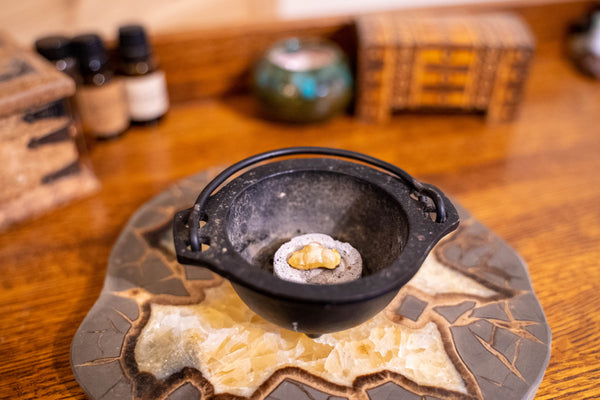3 Virtually Smokeless Ways to Burn Incense
We’ve all been taught that smoke is bad for us. But what about incense smoke? The idea that all smoke is bad is a modern misconception. Incense is the original aromatic medicine - it’s seen across many ancient medical systems that are centuries old and it’s still used today to support the mental, physical, and energetic body.
There are several scientific studies that suggest incense smoke could be bad for your health, but that’s likely due to the fact that a majority of incense on the market these days are full of synthetic chemicals and artificial fragrances that are toxic when burned. And these studies do not differentiate between 100% botanical products versus chemical-based incense.
Burning incense made entirely from plant materials is quite different and is considered to be more therapeutic than harmful. That being said, it’s also true that excessive smoke inhalation, even if it’s considered medicinal, could potentially create negative side-effects over time that may outweigh the benefits; and the amount that is considered “excessive” can vary depending on the individual and their sensitivities. Generally, the average way most people use incense (1-3 times a day or several times a week) is usually not a cause for concern. But like they say, everything in moderation, even medicine.
Luckily, for those concerned about incense smoke, there are many different ways to burn incense, some of which emit very little to no smoke. There’s something mesmerizing about watching incense smoke drift up into the ethers, but there’s also something quite magical about being immersed in an almost smokeless incense experience. Let’s explore the low-smoke and smokeless ways to burn incense and how to practice them. These methods are best for burning single plants, resins, gums, wood chips, bakhoors, or other loose incense types.
The Art of Incense Burning
When burning single botanicals or loose incense on charcoal, people always ask us why their incense smells so strong or like something is burning in the oven. That’s because most people are simply burning their incense at too high of a temperature, or for too long. One of the most typical mistakes made when using this method is placing the incense on too soon, directly after the charcoal was ignited. As a result, the incredibly high temperature quickly burns the aromatic plant material, causing some of it to char immediately and continue charring during the entire burn, tainting the natural aromas from the incense with a burnt smell. This can also release a lot of unnecessary smoke.
To avoid this, it’s important to learn how to control the heat exposure so that your incense burns at a slower pace. This will not only create an incense burning session that is virtually smokeless, but it also maximizes aromatic medicinal benefits and provides a more pure, pleasurable incense burning experience without that singed smell. The three main ways to burn incense with little to no smoke are using the charcoal ash method, the rice ash method, or an electric burner.
Incense Charcoal Ash Method
The connoisseur's trick for properly using incense charcoal is to fully ignite your charcoal and allow it to burn down for between 5 to 15 minutes or until a ¼ - ⅓ inch layer of ash has formed on top of the surface. Then place your incense on top of the charcoal. This will give you just the right heat buffer between your incense and the red-hot ember to slow its burning and give you a much more enjoyable fragrant experience.
This slower, time-released method reduces the chances of burning your incense and allows for a more untainted full-bodied aroma. It also helps reduce the amount of smoke released compared to the most common method of immediately placing incense on a freshly ignited charcoal. This method is the hottest of the 3 we’ll outline and can still release some smoke. The next 2 methods, however, can be smokeless.
Helpful hints
- There are two main types of incense charcoal - self-igniting hookah charcoal and natural hookah or incense charcoal. While self-igniting charcoal is easy to find and use, they contain chemicals like saltpeter to help them ignite with the touch of a flame, which taints the aroma of an incense and can be a risk to your health over the long term.
- If using self-igniting charcoal, ignite them outdoors, allow them to off-gas until they are completely lit (grey in color). If you can, we recommend using natural incense charcoal or the traditional method of using hot charcoal from a fire.
- During your incense burning session, use a metal scraper (a butter or cheese knife works great) to remove spent incense materials before they begin to release any undesired burnt aromas.
Rice Ash Method
This method was developed by masters of the Koh-do incense ceremony, an important centuries-old tradition in Japan. It involves using sifted ash from burnt rice to buffer the heat from a hot charcoal, which allows for a much lower temperature and therefore, longer period of incense enjoyment that’s generally smoke and combustion free.
To practice this method, fill a small cup or bowl halfway full with rice ash and place a fully ignited hot charcoal in the center on top of the ash layer. Bury the charcoal with a small mound of rice ash to create a ¼ - ½ inch thick layer of ash. The thickness of the layer depends on the type of natural charcoal you use and how hot that type typically gets. This will take time, practice, and experimentation to perfect.
You can press down the sides of the mound to pack it slightly with a butter knife or other small, flay utensil, either making a pyramid or a conical shape. The top of the mound is then flattened to create a ½ - 1 inch wide platform for the incense to sit upon. Now you can place loose incense, herbs, wood chips, or incense resins directly on the rice ash platform and enjoy a slow release of aromatic medicine without smoke.
You can also take it one step further and place a flat mica plate on the rice ash platform for your incense to be burnt on. Mica plates are traditionally used in the Koh-do incense ceremony as a platform for the customary incense wood chips like Sandalwood and Agarwood to be burnt upon. They’re made from large flakes of the mineral mica and encased with a thin border of metal wire. They’re commonly used as an added heat buffer as well as for aesthetics.
Helpful hints
- This method is ideal for those that prefer more of a ritual experience who don’t mind the extra effort of setting up.
- You can buy rice ash and mica plates at incense shops or online at highermindincense.com. You can also try sifting ash from your fireplace to use instead.
- During your incense burning sessions, use a small metal spoon or metal tweezers to remove spent incense to keep your aromas fresh.
- Typically mica plates are only used for loose incense and wood chips, not for incense resins since they’ll melt and harden to the mica plate.
Electric Incense Burner Method
Using an electric incense burner can provide you with a precise temperature controlled experience. These types of devices, of which there are many varieties, often have a gauge that allows you to set a certain temperature based on what type of aromatic plants you want to burn. Some require lower temperatures, some higher. Electric incense burners are most commonly used to burn fragrant woods like Agarwood, Sandalwood, and Palo Santo.
Setting an electric burner on low heat settings (around 180 degrees) allows for a longer incense burning experience with unadulterated and pure fragrance that is generally combustion and smoke-free.
Helpful hints
- This method is the most effortless of the 3 outlined here. Great for a quick and easy setup and minimal cleanup. Though it is the most expensive.
- Some electric burners come with disposable foil cups that you can burn and melt resins in, which work great but aren’t very sustainable. While the foil doesn’t seem to emit an aroma that changes the smell of the incense, heating aluminum foil at higher temperatures can also potentially release harmful toxins into the air. If you can find one that fits your burner, a reusable thin steel cup or dish can be used in place of the foil cup and cleaned with alcohol after a few uses for a more sustainable and healthy option.
Conclusion
There are many reasons to explore these ways of incense burning, from creating an experience with little to no smoke, to maximizing health benefits or simply wanting a more pure, unadulterated aromatic experience. There’s nothing worse than buying high-quality organic incense or spending hours making your own to have it get scorched and smell like burnt toast. Hopefully, after reading this article, you’ve gained some new tips and tricks to try in your next incense burning session.
For more educational articles like this one, visit our sister website: NW School of Aromatic Medicine.
Article written by Melissa Szaro
© 2021 The Northwest School of Aromatic Medicine. All rights reserved.
*The statements above have not been evaluated by the FDA, and are for educational purposes only. This article is not intended to diagnose, treat, cure, or prevent any disease. This article should not be taken as medical advice. Please consult your physician before you use this information for health purposes.













